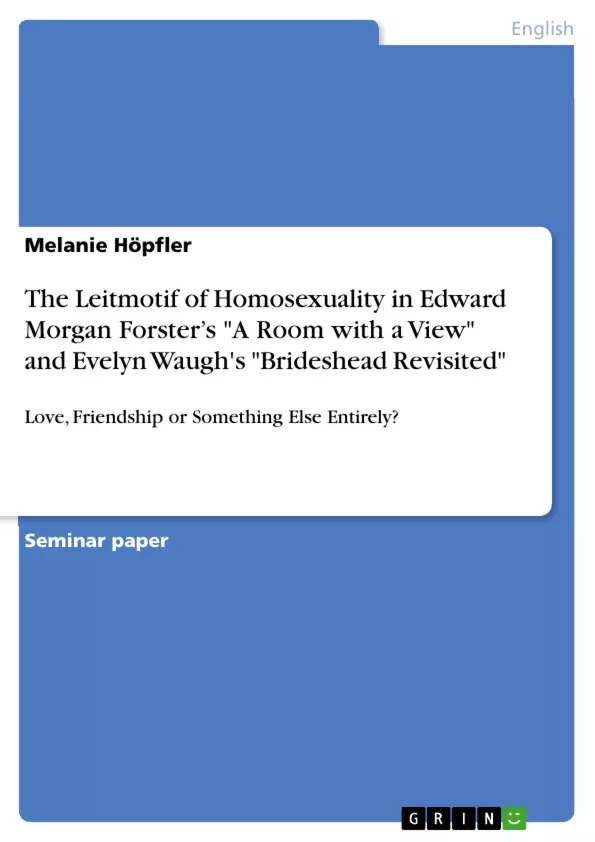This paper will deal with the covert plot and if it can actually be classified as homosexual or if there is another sense of understanding the clandestine plot. Homosexuality is defined by sexual attraction. The intense passion and affection the male characters feel for each other can also depict a deep form of friendship which every person may have experienced once in their life. Sometimes these profound friendships can be confused with love, resulting in faux feelings which are a figment of the imagination.
To argue whether homosexuality is dealt with in the secret plot, the history of homosexuality has to be looked at in the specific time both books have been written and published. The difference for the publications adds up to 37 years — not a short period for history to progress and reshape the minds of the writers and readers. Besides history, faith, especially the Catholic faith, has to be taken into consideration as well. The history of homosexuality will be discussed in the next part of this paper. "A Room with a View" plays in Italy and England; the difference of homosexuality will be shown in both countries in the following section.
Inhaltsverzeichnis (Table of Contents)
- INTRODUCTION.
- HOMOSEXUALITY: ITS MEANING AND HISTORY.
- THE LAND OF DESIRE..
- THE LAND OF INTOLERANCE
- LEITMOTIFS OF FORSTER'S AND WAUGH'S BOOKS.
- DEEP FRIENDSHIP, LOVE OR SOMETHING ELSE ENTIRELY?.
- CONCLUSION..
Zielsetzung und Themenschwerpunkte (Objectives and Key Themes)
This paper aims to explore the presence of homosexuality in the novels A Room with a View by E.M. Forster and Brideshead Revisited by Evelyn Waugh. It analyzes whether the covert plots of these novels, which suggest homosexual relationships, can be classified as such, considering historical and social contexts. The paper also delves into the complexities of defining homosexuality, exploring the nuanced portrayal of male relationships in the chosen novels.
- The historical context of homosexuality in England and Italy during the periods in which the novels were written and set.
- The influence of religion, particularly Catholicism, on societal attitudes towards homosexuality.
- The complexities of interpreting male relationships and the distinction between deep friendship, love, and homosexuality.
- The use of double plots in literature to explore sensitive topics such as homosexuality in a veiled manner.
- The impact of social and cultural constructs on gender roles and their implications for understanding homosexual relationships.
Zusammenfassung der Kapitel (Chapter Summaries)
The introduction sets the stage by presenting the story of Abraham Lincoln and Joshua Speed, highlighting the complexities of defining love and homosexuality. It introduces the concept of double plots in literature, which are used to explore sensitive topics like homosexuality. The first chapter delves into the history of the term "homosexuality" and its evolution. It discusses the influence of religion, particularly Catholicism, on societal attitudes towards homosexuality.
The second chapter focuses on the context of homosexuality in Italy and England, highlighting the different approaches of each country towards same-sex relationships during the periods in which the novels were set. The first chapter discusses the legalisation of homosexuality in Italy and its societal acceptance, while the second chapter explores the historical context of homosexuality in England, where it was deemed unacceptable and even punishable by law for a long time.
Schlüsselwörter (Keywords)
This paper focuses on the keywords and concepts of homosexuality, double plots, historical context, societal attitudes, religion, Catholicism, friendship, love, and gender roles, as they relate to the portrayal of male relationships in the novels A Room with a View and Brideshead Revisited.
- Citar trabajo
- Melanie Höpfler (Autor), 2019, The Leitmotif of Homosexuality in Edward Morgan Forster’s "A Room with a View" and Evelyn Waugh's "Brideshead Revisited", Múnich, GRIN Verlag, https://www.grin.com/document/499304



